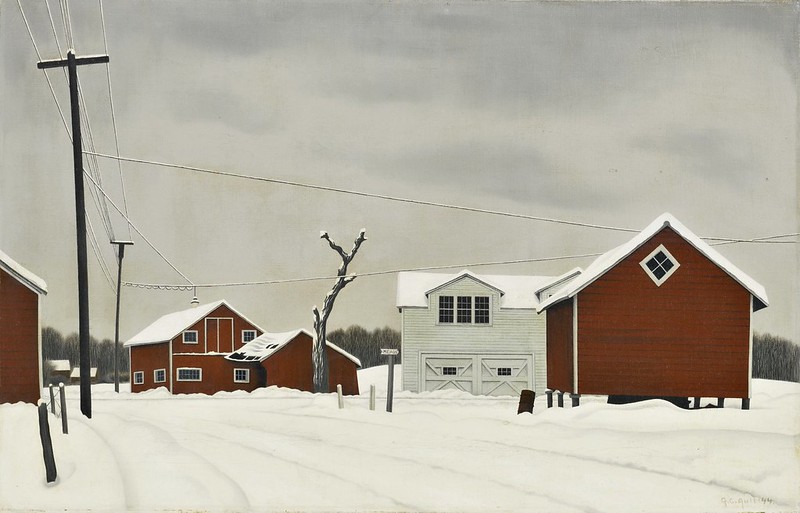Obra de George Ault (1891-1948), pintor nord-americà (1)
- Recordatori de Frederic Cliffe -
En el dia de la commemoració del seu 84è aniversari de decés
Parlem de Pintura...
George Ault (Cleveland, 11 d'octubre de 1891 - Woodstock, 30 de desembre de 1948) va ser un pintor nord-americà. Va néixer en el si d'una família acomodada i va passar la seva joventut a Londres on va estudiar a les escoles d'art de Slade i de St John 's Wood. El 1911 va tornar als Estats Units i va passar la resta de la seva vida a Nova York i a Nova Jersey. La seva vida personal va ser molt problemàtica, especialment amb l'alcohol durant la dècada de 1920 i degut a la mort de la seva mare en una institució mental. Els seus tres germans es van suïcidar després del crac del 1929 i ell va decidir tractar d'oblidar-ho traslladant-se a Woodstock. Va ser en aquest període, i en companyia de la seva dona, que va crear les seves millors pintures si bé va tenir algunes dificultats per vendre-les. Va treballar en oli, aquarel·la i llapis. El seu art es va enquadrar sovint en el preciosisme de pintors com Charles Sheeler i Ralston Crawford degut a les seves representacions precises d'arquitectura i paisatges urbans. Va procurar pintar el que veia al seu voltant simplificant els detalls en plans i superfícies llises i retratant els patrons geomètrics de les estructures. Va ser un pintor analític i al final realista, especialment quan va pintar escenes il·luminades de dia però també de nit. Inestable mentalment degut a les circumstàncies familiars, es va suïcidar el desembre de 1948.
Font: En català: No disponible - En castellano: George Ault (1891-1948) - In english: George Ault (1891-1948) - Altres: George Ault (1891-1948)
Parlem de Música...
Frederic Cliffe (Lowmoor, 2 de maig de 1857 - London, 19 de novembre de 1931) va ser un organista, pianista i compositor anglès. El seu fou un talent prematur ja que els 6 anys ja era intèrpret de piano, amb 11 anys interpretava habitualment a l'orgue d'una església local i als 16 anys va ser l'organista oficial del Bradford Festival Choral Society. El 1883, després d'estudiar al National Training School of Music es va unir a la direcció de docència de piano del Royal College of Music on va tenir, entre molts altres, alumnes com John Ireland i Arthur Benjamin. També va ser professor a la Royal Academy of Music i va viatjar sovint com a pianista. El 1886 va ser l'organista del Festival de Leds, on va arranjar la part de l'orgue de la Missa en Si menor de Bach. A Londres va treballar com a organista del Bach Choir entre els anys 1888 i 1894 així com també en diversos teatres. Com a compositor, va destacar per dues simfonies i un concert de violí. Va morir a Londres el novembre de 1931.
Font: En català: No disponible - En castellano: No disponible - In english: Frederic Cliffe (1857-1931) - Altres: Frederic Cliffe (1857-1931)
Parlem en veu pròpia o en veu d'altri...
The first movement of the First Symphony blazes along with a rapturously emphatic turbulence evocative of Schumann and Tchaikovsky. This is work of utmost seriousness; the very fabric of symphonies. It made me think of Parry's First Symphony - the embodiment of 'sturm und drang'. There are touches of Mendelssohn along the way notably in the lively dancing episodes towards the end of the first movement. That movement is a tempestuous essay drawing its atmosphere from Schumann's Overture, Scherzo and Finale as well as Brahms' Tragic Overture. The second movement (scherzo) is not quite as louring being a lighter yet determined piece standing between Mendelssohn, Smetana (Dance Symphony) and Dvořák as does the finale, evocative of the first movements of Schumann's Rhenish and Spring symphonies. The work's centre of gravity is the Ballade (tr.3) - the longest movement. Cloud and Sunshine is a tone poem expressing life's buffets and delights, all presented in Tchaikovskian finery.
The soloistic textures and expressive moments are far more plentiful than in the case of the Symphony with some lacy filigree work for harp and woodwind. There is some remarkably pleasing work for the French Horns (7.22), chuckling passages for the woodwind at 9.03 and silvery writing for the violins at 11.17. Cliffe shows himself a remarkable craftsman in this piece working within a tradition established by Mendelssohn and Schumann and doing so with eloquent conviction. These two works are captured in vibrantly immediate sound. The notes are by the conductor and will tell you as much as you are likely to want to know about Cliffe. To the best of my knowledge this is the first Cliffe to be commercially recorded in any medium. An essential addition to your catalogue for anyone who favours Goldmark's Rustic Wedding, Mendelssohn's Italian Symphony or the symphonies by Stanford or Lange-Muller. The two works are given splendidly engaged and life-imbued performances by Fifield and the Malmö orchestra. By the time you have heard this you might well be hoping for a second volume containing the Second Symphony (1893) and the Violin Concerto (1897) the latter dedicated to Tivadar Nachez.
Rob Barnett (source/font: aquí)
Gaudiu i compartiu!
Informació addicional...
STERLING: CLIFFE, F. - Symphony No. 1 & Cloud and Sunshine
IMSLP: Frederic Cliffe (1857-1931)
CPDL: No disponible


Un administrador del blog ha eliminat aquest comentari.
ResponEliminaThanks
ResponEliminaNo quedaba ni arroz,super,gracias,Master!!!!!!!!
ResponElimina